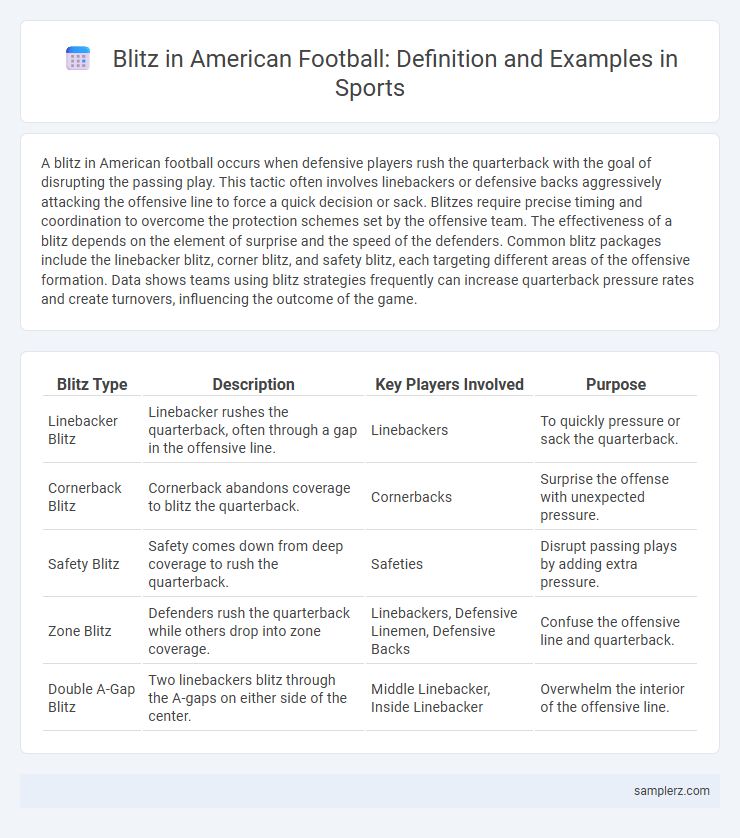A blitz in American football occurs when defensive players rush the quarterback with the goal of disrupting the passing play. This tactic often involves linebackers or defensive backs aggressively attacking the offensive line to force a quick decision or sack. Blitzes require precise timing and coordination to overcome the protection schemes set by the offensive team. The effectiveness of a blitz depends on the element of surprise and the speed of the defenders. Common blitz packages include the linebacker blitz, corner blitz, and safety blitz, each targeting different areas of the offensive formation. Data shows teams using blitz strategies frequently can increase quarterback pressure rates and create turnovers, influencing the outcome of the game.
Table of Comparison
| Blitz Type | Description | Key Players Involved | Purpose |
|---|---|---|---|
| Linebacker Blitz | Linebacker rushes the quarterback, often through a gap in the offensive line. | Linebackers | To quickly pressure or sack the quarterback. |
| Cornerback Blitz | Cornerback abandons coverage to blitz the quarterback. | Cornerbacks | Surprise the offense with unexpected pressure. |
| Safety Blitz | Safety comes down from deep coverage to rush the quarterback. | Safeties | Disrupt passing plays by adding extra pressure. |
| Zone Blitz | Defenders rush the quarterback while others drop into zone coverage. | Linebackers, Defensive Linemen, Defensive Backs | Confuse the offensive line and quarterback. |
| Double A-Gap Blitz | Two linebackers blitz through the A-gaps on either side of the center. | Middle Linebacker, Inside Linebacker | Overwhelm the interior of the offensive line. |
Understanding the Blitz in American Football
A blitz in American football is a defensive strategy where additional players, typically linebackers or defensive backs, rapidly rush the quarterback to disrupt the offensive play. This high-pressure tactic aims to force hurried throws, sacks, or turnovers, increasing the defense's chances to regain possession. Effective blitzing requires precise timing and coordination to avoid leaving gaps in coverage, making it a high-risk, high-reward maneuver.
Key Objectives of a Defensive Blitz
A defensive blitz in American football aims to penetrate the offensive line quickly to sack the quarterback or disrupt the passing play. By applying intense pressure, the defense forces hurried decisions, increasing the likelihood of incomplete passes or turnovers. This aggressive tactic also helps to contain mobile quarterbacks and limit screen plays by overwhelming blockers.
Classic Linebacker Blitz Example
A classic linebacker blitz in American football involves the linebacker aggressively charging through a predetermined gap in the offensive line to pressure the quarterback. This tactic disrupts passing plays by forcing hurried decisions or sacks, often altering the momentum of the game. Linebackers excel at reading the offensive setup and timing their blitz precisely to exploit weaknesses in pass protection schemes.
Cornerback Blitz: Strategy and Execution
A cornerback blitz in American football involves the cornerback aggressively rushing the quarterback, disrupting passing plays by forcing hurried throws or sacks. This strategic defensive maneuver relies on precise timing and effective disguise to catch the offense off guard, often resulting in significant yardage losses or turnovers. Successful cornerback blitzes enhance defensive pressure without compromising coverage responsibilities, making them a valuable tool in modern defensive schemes.
Safety Blitz: High-Risk, High-Reward Play
A Safety Blitz in American football involves the safety abandoning their deep coverage responsibilities to rush the quarterback, creating overwhelming pressure that can force hurried throws or sacks. This high-risk, high-reward strategy often leaves the secondary vulnerable to big plays, demanding precise timing and defensive coordination. Effective execution of a safety blitz can disrupt even the most efficient offenses, turning the tide in critical moments of a game.
Zone Blitz: Combining Pressure and Coverage
Zone blitz in American football strategically combines pass rush with zone coverage, confusing the quarterback by sending unexpected pressure from linebackers or defensive backs while maintaining a secure defensive backfield. This tactic disrupts offensive timing, increasing the chances of a sack or forced throw. Effective execution relies on coordinated defensive line stunts and coverage shifts to mask the blitz's origin and protect vulnerable zones.
Famous Blitz Plays in NFL History
The "Fire Zone" blitz, famously executed by the Pittsburgh Steelers' "Steel Curtain" defense in the 1970s, overwhelmed quarterbacks with its mix of linebackers and defensive backs charging the line. The New England Patriots' "Tampa 2" defense incorporated effective zone blitzes, contributing to their multiple Super Bowl wins by confusing offenses and generating turnovers. One of the most iconic blitz plays occurred during the 1985 Chicago Bears season, where aggressive blitz schemes helped lead the team to a dominant Super Bowl victory.
How Offenses Counter the Blitz
Offenses counter the blitz in American football by employing quick passing plays such as slants, screens, and quick outs to exploit the pressure before it arrives. Using max protection schemes with tight ends and running backs staying in to block minimizes the pass rush impact. Quarterbacks often read blitz indicators and adjust protections or audible to slower-developing plays that capitalize on the vacated zones created by blitzing defenders.
Impact of Blitzing on Game Momentum
Blitzing in American football forces the quarterback into hurried decisions by sending extra defenders, often leading to sacks or turnovers that dramatically shift game momentum. Effective blitzes disrupt the offense's rhythm, increasing pressure that can cause mistakes and fuel the defense's confidence. Teams like the 1985 Chicago Bears used relentless blitzing to dominate opponents, turning defensive aggression into scoring opportunities and controlling the game's pace.
Training Drills for Effective Blitz Execution
Training drills for effective blitz execution in American football emphasize defensive timing, speed, and coordination. Linebacker drills such as rapid-jump starts, gap recognition, and reaction-based pursuit help players identify offensive formations and exploit vulnerabilities. Simulated game scenarios enhance communication between linebackers and secondary defenders, ensuring seamless blitz implementation and minimizing coverage breakdowns.

example of blitz in American football Infographic
 samplerz.com
samplerz.com